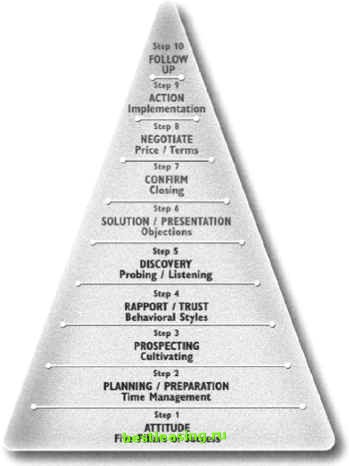

 |
 |

|
Промышленный лизинг
Методички
My informal research suggests that a conversation wont last longer than 20 to 30 seconds before an interruption occurs-someone jumping in with a story, another view. However, in a sales call it can be advantageous to interrupt with questions that clarify your understanding of the situation. I refer to this as productive interruption. Customers are tolerant of clarification questions because the focus remains on them and you are showing interest. To further demonstrate your commitment to the customer and to improve your listening skills, be sure to take notes during the sales call. There is no way you will remember all the details and issues you discussed. In regard to note-taking protocol, be sure to ask permission to take notes when you are in the customers office. Its polite, respectful, and your nonverbal message is, This meeting is important so I need to take some notes. If you are in the neutral territory of a boardroom or a meeting room, you do not need permission. However, ask anyway. If the customer is getting ahead of you and your note-taking, simply interrupt the customer by saying, Thats a great point, let me make a note of that. The customer will be happy to give you a few seconds to complete your notes. At the end of the meeting you might consider summarizing the important points. You can preface this with, As I understand it . . . When you improve your listening skills, you hold a competitive edge. Lucky for you, listening gets scant recognition by your competitors. As we know, listening is not strongly identified in selling and you are not likely to be out-listened by the competition. Theyre too busy trying to get the customer to listen. [2]Dugger, Jim. Learn to Listen. Page 14. 1992. National Press Publications. [3]Dugger, Jim. Learn to Listen. Page 14. 1992. National Press Publications. [4]Bone, Diane. The Business of Listening: A Practical Guide to Effective Listening. Page 5, 1988. Crisp Publications Inc. [5]Bone, Diane. The Business of Listening: A Practical Guide to Effective Listening. Page 5, 1988. Crisp Publications Inc. response.  Even if we arent asked, we willingly lend our views and comments, thinking that we are making a significant contribution. Over the years we have been conditioned to interrupt, or we may not get a chance to share our views, which of course are critical if the conversation is going to have any substance. What fuels our need to interrupt is that we are always thinking of self or sex and we can do it at 1,000 words per minute. With this lethal combination its no wonder we are poor listeners. Effective listening means more than refraining from the bad habit of interrupting. Good listening means being satisfied to listen to the entire message rather than waiting impatiently to jump in with your ЦШ И1:11 ЦИЛЛИЛШ Notes 1. Customer Based Research Conducted by Spectrum Training Solutions Inc. 2. Dugger, Jim. Learn to Listen. Page 14. 1992. National Press Publications. 3. Bone, Diane. The Business of Listening: A Practical Guide to Effective Listening. Page 5, 1988. Crisp Publications Inc.  Congratulations, you have now completed Step #5  previous next Chapter 8: Presentation Skills: Value-Added Solutions Congratulations on another graduation. You have successfully worked through the first five steps of the Sequential Model, doing the groundwork to meet and exceed your customers expectations. This next step applies to potential new customers as well as existing customers to whom you are presenting a new product or service. So what is a value-added solution? It means enhancing your solution by exceeding the expectations of your customers. It means going outside the traditional role of a sales representative to provide a solution that truly elevates you above your closest competitor. Customers buy differences, not similarities. The challenge is finding innovative, unique ways to exceed expectations. Cookie-cutter solutions and boring, ho-hum presentations are all too common. As Larry Wilson writes in his book, Changing the Game: Instead of trying to find prospects who fit my presentation, what I needed to do was fit my presentation to the prospect I found. m A simple idea, but it changed selling for me. Unfortunately for customers, sales representatives continue to try to fit them into canned, rehearsed presentations. Or they try to close the sale based on price, instead of offering a value-added solution. Sadly enough, customers are often saddled with the burden of trying to differentiate among proposals that imitate each other-me-too, cookie-cutter solutions that seduce customers with little more than the lowest price. Your responsibility is to make it easy for your customer to decide, to remove the stress of uncertainty. Why Should I Buy From You? Why should I buy from you? is a universal question, one that stalls the call and puts salespeople into a tailspin, struggling with a response that does little to excite the customer. Ive seen it happen far too often. Openly challenged, the salesperson retreats deep into his or her comfort zone responding with a well-rehearsed feature dump, hoping to avoid a crash and burn situation. We know the result all too well. Another presentation ending in tragedy, another lost sale. The Why should I buy from you? question needs to be answered with a well-prepared presentation that addresses the benefits of both parties doing business together. Your success relies on how well you probed, identified expectations, and then satisfied those expectations by presenting the attributes your company can offer. Dont make the all-too-common mistake of telling your story from your point of view, but rather present your story from the customers point of view. You must weave appropriate benefits into your presentation so that customers clearly see your solution as helping their business run more efficiently. True story: Two gentlemen were getting their hair cut. Person A was a VP at a large oil company and person B was the president of a different company. Person A knew B and introduced himself and his company saying, My people were recently in to see your people. Person B responded by saying, in his Texas accent, Thats interesting. What you-all goin to do for us? I couldnt have said it any better myself. Customers expect innovative, value-added solutions that become assets to their business. If you are doing a good job, you should be aware of your customers expectations. Your presentation does not happen in isolation. It is supported by the first five steps of the Sequential Model, including a thorough Discovery step, earning the right to present. Remember, your model allows for no missing pieces. mWilson, Larry. Changing the Game: The New Way to Sell. Page 81, 1987. Simon & Schuster Inc.. iiMj..HiiH i jjj*ii.nuiBaa 1 2 3 4 5 6 7 8 9 10 11 12 13 14 15 16 17 18 19 20 21 22 23 24 25 26 27 28 29 30 31 32 33 34 35 36 37 38 39 40 [ 41 ] 42 43 44 45 46 47 48 49 50 51 52 53 54 55 56 57 58 59 60 61 62 63 64 65 66 67 68 69 70 71 |